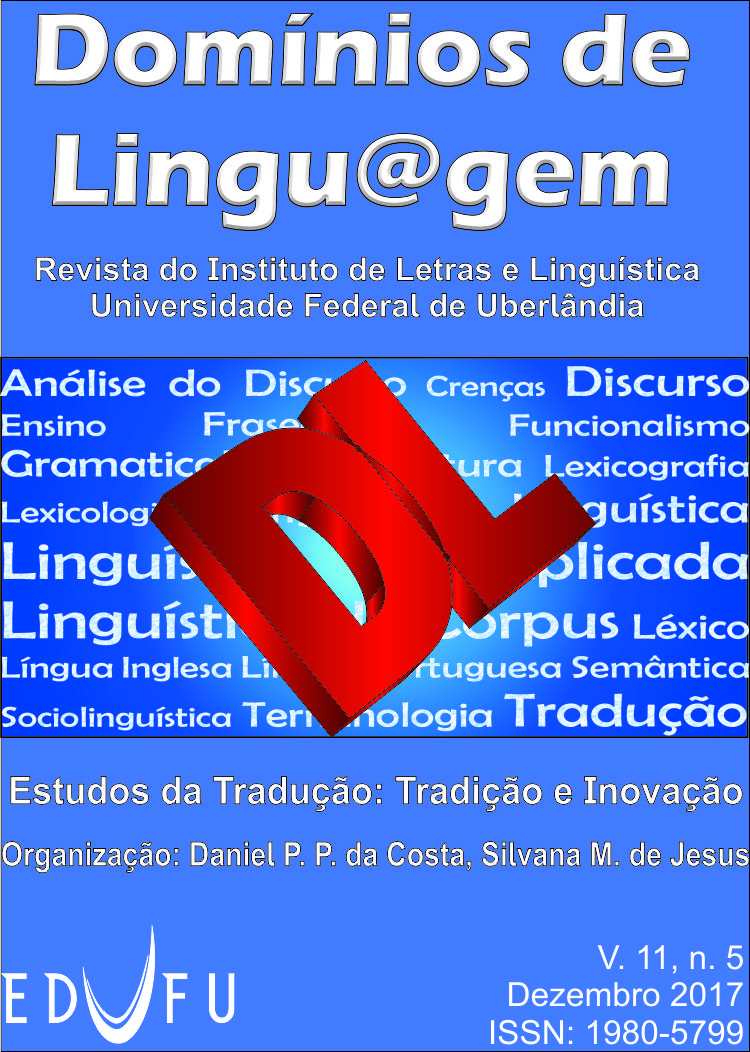Tradução Oral à Prima Vista na formação do intérprete
considerações pedagógicas
DOI:
https://doi.org/10.14393/DL32-v11n5a2017-15Palavras-chave:
Tradução Oral à Prima Vista, Abordagem metodológica para ensino-aprendizagem da TrPV, Formação de intérpretesResumo
A Tradução Oral à Prima Vista (TrPV) é um elemento de relevância para a formação do intérprete e um componente essencial para o desempenho do futuro profissional em muitos ambientes de atuação. Consequentemente, a prática da TrPV se faz presente em cursos de formação bem estruturados. Neste escrito, após uma breve referência à natureza, complexidade e desafios impostos pela TrPV, e tendo como base uma vivência docente extensa da autora, será apresentada uma possível abordagem pedagógica, voltada à aquisição da competência em TrPV e a um desempenho de qualidade nessa modalidade híbrida, situada no espaço fronteiriço tradução escrita e tradução oral.Downloads
Referências
ANGELELLI, C. The Role of Reading in Sight Translation. The ATA Chronicle, Alexandria, n. 38, p. 27-30, 1999.
AGRIFOGLIO, M. Sight Translation and Interpreting: A Comparative Analysis of Constraints and Failures. Interpreting, Amsterdam / Philadelphia, v. 6, n. 1, p. 43-67, 2004. https://doi.org/10.1075/intp.6.1.05agr
CIOL (Chartered Institute of Linguists). DPSI Handbook for Candidates. 2015. Disponível em: http://www.ciol.org.uk/sites/default/files/Handbook-DPSI.pdf. Acesso em: 10 dez. 2016.
GILE, D. The effort models of interpreting. In: ______. Basic Concepts and Models for Interpreter and Translator Training. Amsterdam; Philadelphia: John Benjamins Publishing Company, 2009, p. 157-190. https://doi.org/10.1075/intp.11.1.08gil
HERBERT, J. The Interpreter’s Handbook – How to Become a Conference Interpreter. Genève: Librarie de L’Université, Georg & Cie S.A., 1952.
JAKOBSEN, A. L.; JENSEN, K. T.H. Eye movement behaviour across four different types of reading tasks. Copenhagen Studies in Language, Copenhagen, v. 36, 2008, p. 103-124.
JIMÉNEZ, A. La Traducción a la vista. Un Análisis descriptivo. 1999. 415 f. Tesis (Doctorado en Lingüística i llengües) – Universitat Jaume I, Facultat de Ciênces Humanes i Socials. Castellón, Espanha, 2009. Disponível em: http://www.tdx.cat/bitstream/handle/10803/10564/jimenez-tdx.pdf?...1. Acesso em: 17 set. 2004.
MIKKELSON, H. Text analysis exercises for sight translation. In: ANNUAL CONFERENCE OF THE AMERICAN TRANSLATORS ASSOCIATION, 34., Metford, 1994. Proceedings... Metford: NJL, Learned Information, 1994, p. 381-390.
MOSER-MERCER, B. Sight Translation and Human Information Processing. FORUM ON TRANSLATION STUDIES, 2., Kent, 1991. Proceedings... Kent: Institute for Applied Linguistics, 1991, p. 159-166.
PÖCHHACKER, F. Introducing Interpreting Studies. London; New York: Routledge, 2004.
SAMPAIO, G. R. L. Mastering Sight Translation Skills. Tradução & Comunicação, São Paulo, n. 16, p. 63-69, 2007.
______. Sight Translation Step by Step. Different Approaches to Interpreter Training. CONFERENCE OF AMERICAN TRANSLATORS ASSOCIATION, 50., New York, 2009, Proceedings... New York: ATA’s 50th Annual Conference, 2009.
______. Exploring the Interface: Sight Translation in Translator and Interpreter Training. CONGRESSO LATINOAMERICANO DE TRADUCCIÓN Y INTERPRÉTATION, 5., Buenos Aires, 2011. Actas... Buenos Aires: CTBA Editorial, 2011.
SELESKOVITCH, D.; LEDERER, M. The Interpretation Process. In: ______. A systematic Approach to Teaching Interpretation. Translated by Jacolyn Harmer. Luxembourg: Office for Official Publications of the European Communities, 1989, p. 21-26.
SYYSNUMMI, L. Cognitive Load during Sight Translation – an Experimental Study. 2003. 40 f. Master’s Degree (Dissertation in Letters) – Translation Studies Program, University of Turku. Turku, Finland, 2003.
VIAGGIO, S. The Praise of Sight Translation (and squeezing the last drop thereout of). The Interpreters’ Newsletter, Trieste, n. 4, p. 45-58, 1992.
WEBER, K. W. The Importance of Sight Translation in an Interpreter Training Program. In: BOWEN, D.; BOWEN, M. (Ed.). Amsterdam; Philadelphia: John Benjamins Company, 2008, p. 44-52. https://doi.org/10.1075/ata.iv.10web
Downloads
Publicado
Edição
Seção
Licença
Autores que publicam nesta revista concordam com os seguintes termos da licença Creative Commons
CC BY-NC-ND 4.0: o artigo pode ser copiado e redistribuído em qualquer suporte ou formato; os créditos devem ser dados ao autor original e mudanças no texto devem ser indicadas; o artigo não pode ser usado para fins comerciais; caso o artigo seja remixado, transformado ou algo novo for criado a partir dele, o mesmo não pode ser distribuído.
Autores têm autorização para assumir contratos adicionais separadamente, para distribuição não-exclusiva da versão do trabalho publicada nesta revista (ex.: publicar em repositório institucional ou como capítulo de livro), com reconhecimento de autoria e publicação inicial nesta revista.









